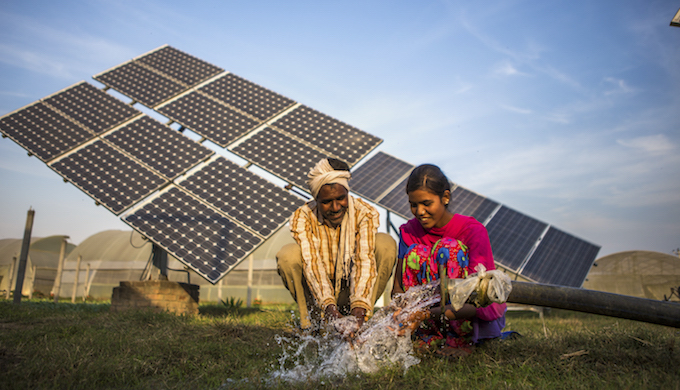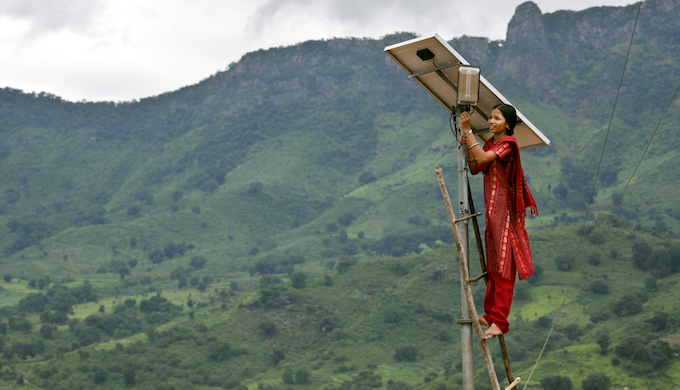India aims to deploy as many as 10,000 mini grids based on renewable energy sources to sustainably provide electricity to villages in remote locations

Mini grids based on renewable energy sources can be a viable model for India. (Photo by Prashanth Vishwanathan)
The Ministry of New and Renewable Energy (MNRE) in June presented a draft national policy on mini and micro grids powered by renewable energy (RE) sources that aims to build at least 10,000 of them across India with a minimum installed RE capacity of 500 MW in the next five years. With reducing costs and increasing efficiencies of RE technologies, RE-based micro and mini grid solutions are being seen as a durable solution that will be able to provide reliable and cost-effective energy service, the draft says.
This optimism appears to be reflected by industry experts. Jyoti Deka, a microgrid analyst at Customised Energy Solutions, says there are a number of positives in the document. The first is the explicit provision of exit options for microgrid operators in case the national grid arrives in their areas of operation. “The policy has done away with the ambiguity in this regard and marked three distinct options for a microgrid operator to manage such a risk. Furthermore, it encourages new entrants to the microgrid industry by removing the obstacle of credit rating which was a MNRE empanelment requirement for many of the energy service companies (ESCOs) wanting to establish their business and avail subsidy,” Deka told indiaclimatedialogue.net.
Harish Hande, Managing Director, SELCO-India, also thinks that it is a welcome step, together with earlier policies on decentralised generation under the National Solar Mission and Deendayal Upadhyaya Gram Jyoti Yojana, a rural electrification scheme. The draft, he said, “brings some amount of clarity on the technical and operational aspects, specifically around how the mini-grid interfaces with the existing grid.”
However, as far as its feasibility and workability go, he believes “it is more of an information document”. The targets laid out in the policy are not binding on any state as of now, and there are no implementation timelines. Also, while the proposed role of panchayats and village energy committees is a great concept on paper, without the right kind of training available to the local youth, these mechanisms rarely work in reality. “In case of future interconnection with the grid, there continues to be a lack of clarity on tariffs that will be offered to developers. Without fixing the accountability and ironing out the operational and financial challenges, projects might not take off on the ground, and if they do, they find it difficult to sustain in the long run,” he told indiaclimatedialogue.net.
Deka also points to a number of lacunas, such as not having an ambitious target for installed capacity (the policy states a target of 500 MW by 2021, but the actual potential is far higher) or not stating exclusively whether the RE-based mini-grids should receive preferential feed-in tariff and contribute towards the state distribution company’s (Discom’s) Renewable Purchase Obligation (RPO) targets if they are connected to the grid. “The good news though is that in subsequent consultations with stakeholders held at MNRE, these gaps have been deliberated and the ministry has taken suggestions to address them in the final version,” Deka added.
Powering remote areas
When it comes to providing power to areas that not reached by the national grid, mini and micro grids have been immensely useful. A study by the International Energy Agency, published in the latest World Energy Outlook, states, “Even though majority of Indians continue to receive their power via the grid, mini-grid and off-grid solutions provide more than half of the electricity supply to those gaining access, especially in areas distant from the existing transmission lines or of lower population density.”
The ministry draft mentions the use of alternate sources of energy to power remote hamlets and villages. It states, “Along with the support to large scale RE, the ministry promotes decentralised solutions based on sources such as solar, biomass, biogas, wind, small hydro, for meeting the lighting needs, other electricity and thermal requirements especially in rural areas through separate programmes.”
According to G. Prasad, Director, Offgrids, MNRE, mini grids are the ultimate solution for 24×7 power in rural areas of the country. “The advantage is produce power locally and consume locally. Moreover, there is no need to transmit power from one place to other,” Prasad said.
Positive that this move will solve power woes in India, he said, “This programme is a boon for power-deficit areas. However, people’s participation is necessary. The public should realise that this facility has been created for their present and future power requirement.”
Agreeing, Deka said that the policy actually talks about enhancing power quality, reliability and has mandated features like minimum performance standards of micro grid operation. “So on this front, it is very much in sync with the government’s Power For All and 24×7 agenda. The only missing link or contrast is perhaps the period by which that will become a reality.”

A woman carrying out maintenance work on a solar panel. (photo by Abbie Trayler-Smith)
According to Hande, over 250 million people still don’t have access to electricity in India, and many more have only sporadic access. Though this policy will not solve all power woes, it will lay the foundation for more enterprises and entrepreneurs to find innovative ways to deliver last mile connectivity to this under-served population, he said. The success of this policy in the long term would depend on the inclusion of more grassroot practitioner perspectives into the policy framework, he added.
While the MNRE has been stepping up these efforts, there is a parallel push by the Ministry of Power to supply 24×7 power for all through the national grid. “In our experience, it has been documented that there are specific times and locations where decentralised RE systems are much more compatible and financially viable, even in the medium to long term. The Power for All plans must therefore take cognizance of these efforts in the nationwide electricity plans,” Hande said.
Cost-effective solution
Prasad said the use of RE-based sources of power would also bring down production cost, since the programme is based using resources like wind, hydro and locally available biomass, apart from solar. The combination of these resources would bring down the production cost of power, he felt.
Hande did not agree. “What it will do is reveal the true cost of electricity provision, and the amount of cross-subsidies and inefficiencies involved in supplying electricity through the grid from conventional sources,” he said.
The policy, Hande explained, intends to fix the tariffs for mini-grids that are connected to the distribution infrastructure. But for mini-grids operating as standalone systems, ESCOs are free to charge the customers whatever they want. The cost of this electricity would be far higher than that of electricity from the grid. An effort has to be made to address this inequity, Hande suggested, since underprivileged rural customers pay the true cost of electricity for decentralised renewable electricity, while the government uses taxpayer money to pay for the inefficiencies of grid electricity.
On a related note, the delivered cost of electricity through decentralised RE is also high because ESCOs are forced to recover their capital costs quickly. This often translates into high tariffs. If in the longer term, cheaper credit is made available to ESCOs, they may be able to transfer these benefits to the end-users, Hande said.
Deka said, “It has the potential to make micro grids more popular by encouraging more and more entrepreneurs and perhaps with scale cost will also lower. However, it is a little early to comment how fast the reduction of cost will happen.”
Relevance of microgrid models
The draft policy is giving the right signals to the industry to pursue such models, say experts. Deka explains that microgrids have been operational in parts of India’s rural belts for quite some time and the only thing that remains to be seen is the execution of a self-sustainable model for a relatively significant life. Microgrids in urban and rural areas require different business models to merit a commercially successful outcome or to meet the welfare agenda of power to all in a sustainable manner.
While microgrid models are useful in several ways and have found multiple applications globally, in India, they serve two major purposes in geographically distinct ways. Firstly, they solve the issue of quality convenient energy access in areas that are rural or remote. Secondly, they can build and improve resiliency and power quality issues in either isolated or grid-tied manner if executed to serve critical urban infrastructures.
A pilot solar microgrid model established at Dharnai village panchayat in Makhdumpur block, Jehanabad district, Bihar, could show the way.
Challenges
One of the main challenges in implementing the policy, according to Prasad, is mindset. “Ultimately, nothing comes free. People’s participation by paying monthly charges is the main issue,” he said.
Some of the issues, according to Deka, include access to finance, quality manpower, payment collection and timely disbursement of subsidies. “These are likely to remain among key hurdles of implementing and operating micro grids, more so in rural areas.”
Another challenge is raising finances by developers. “If these issues are tackled, I feel there is lot of future for min-grids in the country, which is part of a 24×7 programme initiated by the government”, Prasad said.
State Nodal Agencies have been asked to find appropriate sites for mini-grid projects. Hande would like more transparency in this selection process. “From our experience, it is clear that in some of the remote sites, physical and social conditions would not be ideal for mini-grid solutions,” he said. “Standalone home energy systems are much more economical and appropriate in these locations. It would be good for the policy to lay out some guidelines for this site selection process.”

Trackbacks/Pingbacks